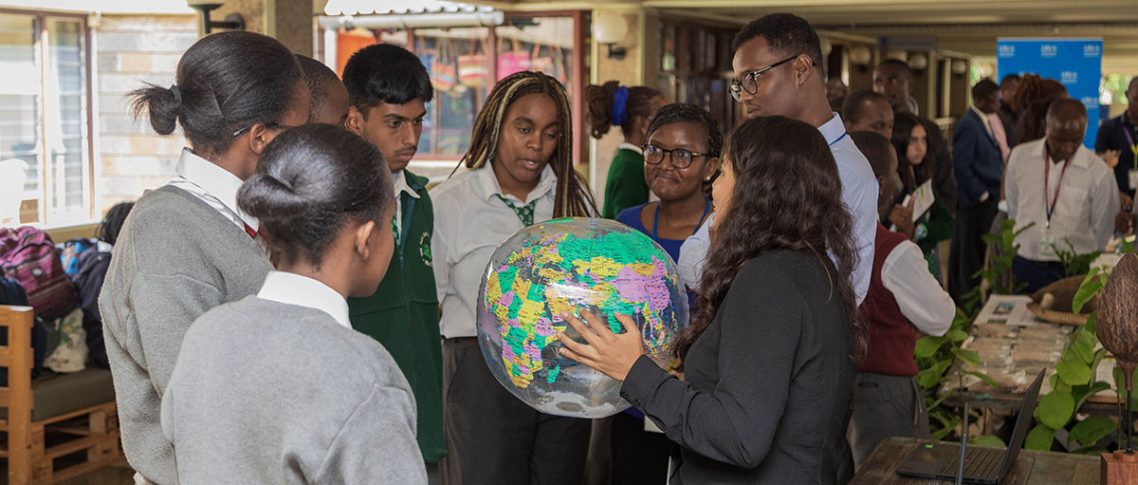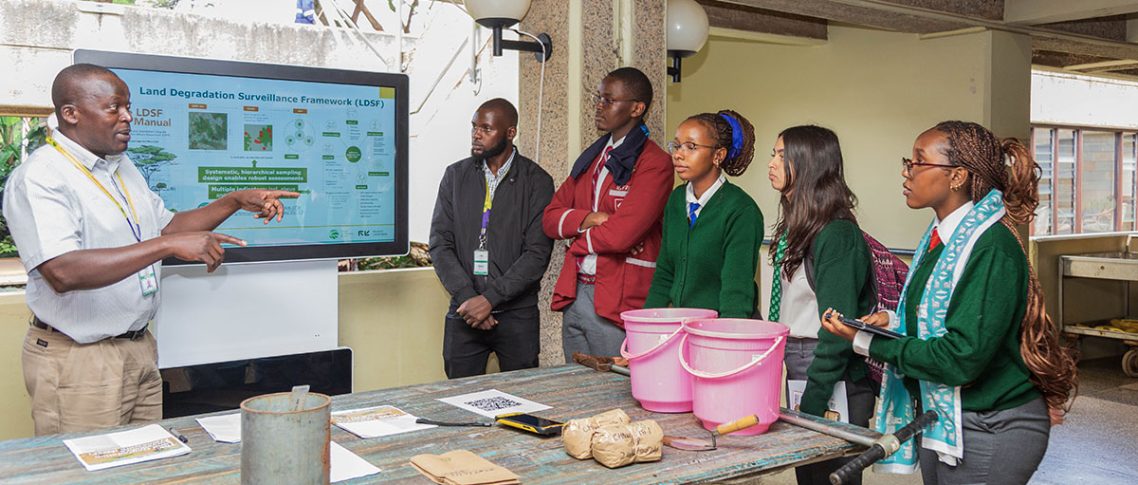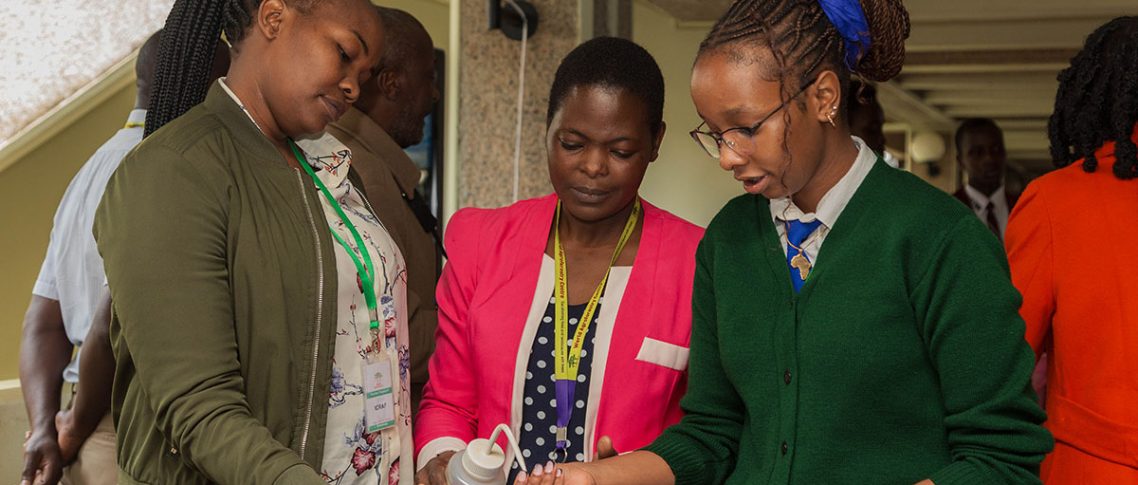
With almost a quarter of Earth’s land area degraded, affecting 3.2 billion people – 40% of our total population – the loss of terrestrial ecosystems is a planet-wide crisis. In Kenya, this crisis is particularly pressing, with almost 80% of the total landmass affected by land degradation.
To raise awareness of this issue – and potential solutions and action pathways – amongst Kenyan young people, the Center for International Forestry Research and World Agroforestry (CIFOR-ICRAF) and the United Nations Environment Programme (UNEP) co-hosted a workshop on soil management in Nairobi, Kenya. Participants included young people from three neighbouring high schools, as well as UN personnel and their children.
The June 5 workshop was held to celebrate World Environment Day, the United Nations Day for encouraging worldwide awareness and action to protect our environment. This year’s campaign focused on restoring land, halting desertification and building drought resilience, calling on governments and multilateral organizations to fulfil their commitments, and raising awareness among civil society groups, businesses and individuals on the theme.
“This year’s World Environment Day really highlights the importance of collaboration across organizations, and with farmers and land managers, to scale landscape restoration efforts, from the soil up,” said Leigh Ann Winowiecki, CIFOR-ICRAF systems scientist and global Soil and Land Health Theme leader. Soil health is a cross-cutting topic that sits at the intersection of several multilateral environmental agreements and international policy frameworks, including the Sustainable Development Goals (SDGs), the United Nations Convention to Combat Desertification (UNCCD) and the UN Decade on Ecosystem Restoration, among others. “At CIFOR-ICRAF, we see soil as a unifier,” said Winowiecki.
Demonstration stations: soil health monitoring from field to sky
The workshop entailed six demonstration stations that illustrated various elements of soil health monitoring. The first station showcased the basics of soil management, including soil definition; soil formation factors; degradation of soil across the globe; and impacts on climate, biodiversity, and human well-being. The second station illustrated soil collection processes using the Land Degradation Surveillance Framework (LDSF), which is deployed to gather data – on vegetation, shrubs, land cover, and soil – at a landscape level.

The third station focused on soil analysis for evidence-based monitoring and policy making, including spectral soil analysis using infrared and X-ray light. There, the CIFOR-ICRAF Soil and Land Health team showed students how to use portable Alpha and X-Ray Fluorescence spectrometers, which enable efficient and cost-effective soil analysis. They also discussed applications of spectroscopy – such as monitoring soil health indicators like soil organic carbon, detecting and monitoring of soil contaminants and pollutants, and soil mapping – and shared the ‘living’ aspect of soil, including its abundant and diverse range of macro- and micro-organisms and the role they play in soil health.
At the fourth station, CIFOR-ICRAF’s Spatial Data Science and Applied Learning Laboratory (SPACIAL) demonstrated how artificial intelligence and machine learning are improving insights into land health, and being harnessed to monitor landscape changes such as land degradation from the sky, by creating maps using Earth Observation tools. The station also showed how several apps, such as the Regreening Africa App – a citizen science application for collecting restoration data – are utilized in landscape monitoring.
The CIFOR-ICRAF Tree Genebank team, at the fifth station, stressed how critical it is to plant the right trees in the right places by matching diverse tree species to restoration sites. Developing good practices that help nurture healthy seedlings in nurseries, and well-informed decisions on tree selection, are essential to avoid growing a limited range of exotic species that could fail due to climate change or become invasive. The team demonstrated the functions of their laboratory and shared various knowledge resources and tools such as the Africa Tree Finder App, which provides tree growers with information on indigenous tree species options – and the products and services they provide – for a given restoration or agroforestry site based different natural vegetation types.
“Sharing knowledge on the value of existing huge tree species diversity – and its contribution to people’s livelihoods and the stability of our environment – is essential and urgent for young learners as the next stewards of this priceless inheritance,” said CIFOR-ICRAF agroforestry scientist Sammy Carsan.

At the sixth and final station, the participants were introduced to the UN Decade on Ecosystem Restoration as an example of a global movement for local action, and explored opportunities to join and act. The Decade recognizes and celebrates seventeen World Restoration Flagships, including the Regreening Africa project, which it deems the best examples of large-scale and long-term ecosystem restoration in any country or region, embodying the ten Restoration Principles of the UN Decade.
‘Fierce problems’, fresh solutions
At the workshop’s close, CIFOR-ICRAF gifted each school with tree seedlings to be planted in their areas of choice in honour of World Environment Day and as a reminder to participate actively in land health restoration. “The experience was really enlightening: I have learned how I can avoid soil erosion, and how to keep soil healthy,” said 15-year-old Adrian Tinega, a student at Aga Khan Academy. “It was fun getting my hands dirty! I like the technology that I can use to know more about soil, like satellites – maybe one day I can be using it in my day-to-day life.”
Khalil Walji, CIFOR-ICRAF scientist and Landscapes For Our Future project coordinator, said that it is critical to involve youth in land restoration efforts because they are current land stewards and future leaders. “Students and young people offer fresh perspectives and innovative solutions to the fierce problems we face,” said Walji. “Our learning journey at CIFOR-ICRAF grounds them in the basics of soil health and guides them through the comprehensive process we take, from fieldwork to laboratory analysis and advanced remote sensing to unlock landscape-level insights and generate advanced analytics enabling us to target degradation hotspots and prioritize key areas for ecological restoration.”
The event also attracted Kenya’s First Lady’s Mazingira Awards (FLAMA) initiative, which recognizes the role of learners in the environmental and climate crises. Sheila Shefo Mbiru, FLAMA’s programme head, commended the learning programme, noting that young people can be agents of change if empowered and equipped to become environmental stewards, climate action champions and restoration ambassadors. “We all have a part to play in land restoration, addressing desertification and building drought resilience in securing a sustainable future for Kenya,” said Mbiru.
We want you to share Forests News content, which is licensed under Creative Commons Attribution-NonCommercial-ShareAlike 4.0 International (CC BY-NC-SA 4.0). This means you are free to redistribute our material for non-commercial purposes. All we ask is that you give Forests News appropriate credit and link to the original Forests News content, indicate if changes were made, and distribute your contributions under the same Creative Commons license. You must notify Forests News if you repost, reprint or reuse our materials by contacting forestsnews@cifor-icraf.org.
